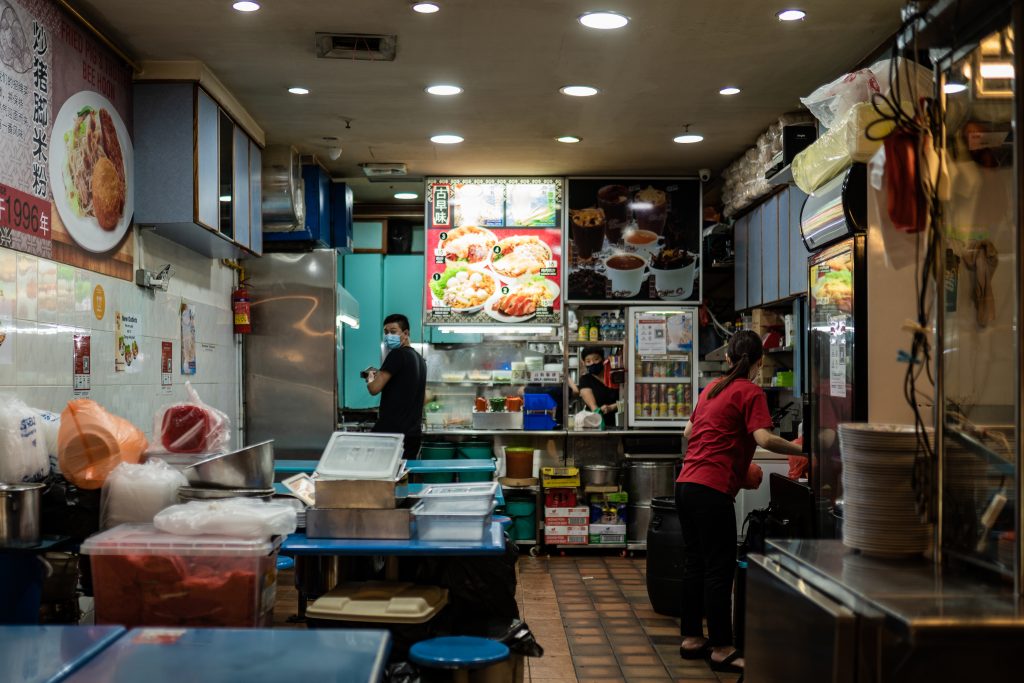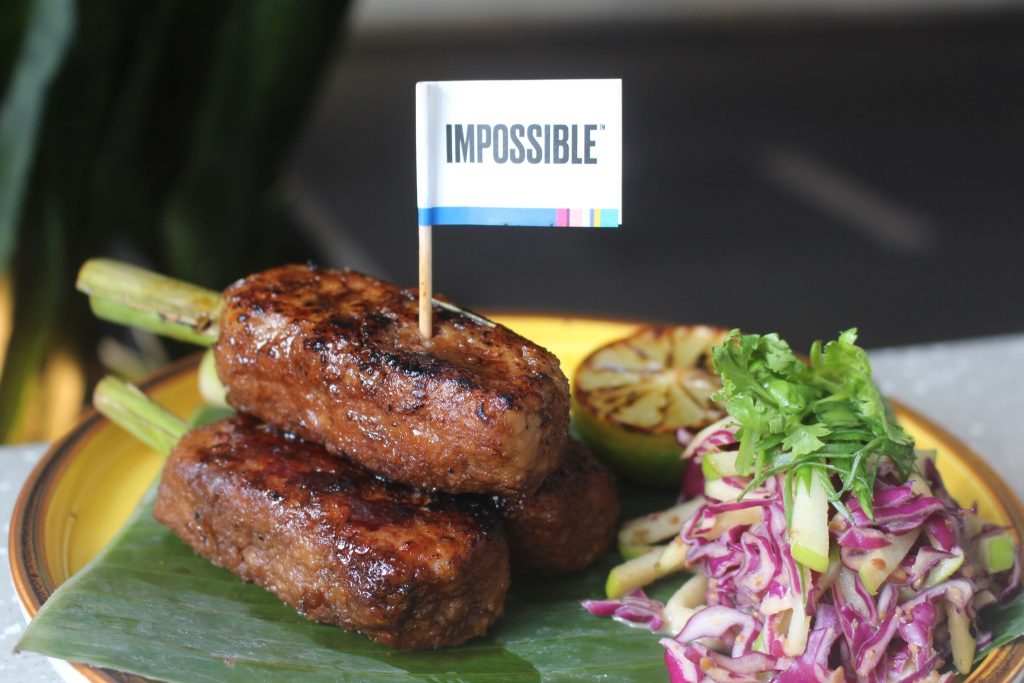Top image: Zachary Tang / RICE File Photo
It’s 7 pm, deep into dinner rush hour. In a nondescript hawker centre, hawkers recall the sweltering heat of propane stoves and the impatient throngs of customers that used to come hand-in-hand with this time of day. But now, they look longingly at crossed-out tables and the occasional passer-by. Friends from neighbouring stalls, some having operated for decades, are shuttering for the last time. They are considering doing the same.
A tale of two eateries
Across the Singapore River, a hotshot restaurant serves concoctions straight from science-fiction: dishes feature chicken meat grown from stem cells that have never touched a feather. Just beside, a café sells cheeseburger sliders made from plants so meat-like it might fool you. Both are churning out orders so fast that waiters can’t catch a breath.
This is the Singaporean food scene today. Hawker culture might be a UNESCO cultural heritage, but demand has been steadily slumping, especially as young people turn to malls and cafés for their gatherings instead. In fact, the historic recognition of hawker culture might just be what renders it historical, a relic of the past. Hawker food also suffers from the unshakeable perception of affordability—a boon for eaters, but a curse for hawkers whose margins remain razor-thin. All of the above, coupled with COVID restrictions decimating hawker incomes, has led to the beginning of hawker food’s slow, painful demise.
Simultaneously, however, Singapore has been on the cutting-edge of the recent insurgence in plant-based meats and cultured meats (meat grown in-vitro). The government has readily injected millions in funding to local food-tech start-ups to develop large-scale plant-based meat production, while foreign plant-based firms have expanded rapidly into our markets. Singapore is also the world’s petri-dish for cultured meat—we are home to the world’s first restaurant serving cultured meat, as well as the first-ever commercial cultured meat production facility.
And yet, strangely, none of this makes sense. These two phenomena, though concurrent, are entirely contradictory. How is Singapore’s food culture dying and thriving simultaneously?
Ultimately, this could be due to Singapore’s unique status as a gastronomical hub and an economic powerhouse. The former makes it a no-brainer for local food-tech companies to thrive and foreign ones to invest here. After all, Singapore is the country that loves food above all else. But, ironically, the more Singapore develops economically, the more that perception fades; would-be hawker successors turn to cushy corporate positions while hawker fare devolves into an inferior good. All while food-tech firms continue burgeoning.
Out with the old, in with the new — our food culture is now a serpent eating its tail. The rise of trendy, modern food-tech like plant-based and cultured meats will inevitably cannibalise our traditional hawker culture — both in the press and, eventually, on our plates.

A way out—embracing change
It doesn’t have to be like this. There is a way to reconcile the paradox and lead hawkers out of this rut. The solution? Hawkers should embrace alternative meat to thrive in the long term.
The end goal is to create a paradigm shift in the perception of hawker culture as a whole. Alternative meats like Impossible and Beyond currently hold immense cultural cachet in our society as they are presented as an environmentally-friendly and ethical alternative to factory farming.
Plant-based meat like Impossible Beef generates a tenth of the greenhouse gas emissions of animal meat, while cultured meat entirely bypasses the cruelty of standard meat production practices. This has made them attractive to younger generations whose enthusiastic expenditure has made them nearly ubiquitous in Singapore. If alternative meats were readily accessible in hawker food, it could redefine what hawker food can be—not just the tradition of the past but the food of the future.
This idea has worked elsewhere, namely in the restaurant sphere. Many Singaporean restaurants have begun using plant-based or cultured meats to great fanfare—well-known franchises like Tim Ho Wan and PS. Cafe have readily adopted Impossible Pork into their menus.
Notably, Stuff’d recently replaced all their animal beef options with Impossible Beef, becoming the first Asian fast-food chain to do so. Some restaurants have even begun making atas hawker food with plant-based meats, from Mee Tai Bak with Impossible Pork at New Ubin Seafood, to Impossible ngoh hiang at Cai Eats. If restaurants can ape hawker fare to immense success, why not actual hawkers themselves?

Crucially, the usage of alternative meats in hawker food can’t be just about a couple of young upstart “hawkerpreneurs” using it as a marketing gimmick. There is no shortage of hipster hawker stalls selling trendy lattes and gourmet burgers, but they don’t move the cultural needle in any perceivable way; they are simply aberrations in the dying hawker landscape.
For this to work, the presence of alternative meats needs to be a system-wide restructuring. Only then will younger generations be convinced that hawker food at large deserves their dollar votes again.
Of course, this is easier said than done. “Hawkers embracing change” might be the single most improbable proposition ever to exist. We’re talking about aunties who have perfected their craft over decades and uncles who snap at you if you don’t order in a millisecond. These are some of the most obstinate humans to walk the earth. One could never expect hawkers to make such a drastic change on a large-scale, grassroots level.
This is why top-down government action is necessary.
Government should provide hefty rebates for hawkers to source their “meat” from local plant-based meat firms, particularly effective if “meat” prices fall below those of animal meat. This would create a win-win-win situation.
Hawkers are incentivised to purchase the cheaper “meat”, which helps their bottom line, and increased footfall will be a welcome bonus. Local plant-based meat firms get access to a vast customer base to boost their growth further, allowing them to scale effectively. And the government manages to make advances in various objectives—it gets one step closer to its goal of achieving partially self-sufficient food security by 2030 and secures a sustainable method of reducing emissions.
What could possibly go wrong?
Well, a lot.
Firstly, and most evidently, the logistics are more than a long shot. Getting the government to cough up on such a radical solution will require a herculean effort, especially when so much investment is already poured into homegrown food-tech start-ups. What is encouraging, however, is that the government already appears keen to help hawkers modernise.
For instance, ample resources have been spent to help hawkers go digital, encouraging the adoption of SGQR, a unified e-payment service. Such an alternative meat policy may thus fall in line with what policymakers have in mind to support hawkers into the future.
Still, the more significant issue is the cost of production. Today, the prospect of producing alternative meats at a price point cheaper than normally-harvested meat is still wishful thinking. Even for established brands like Impossible Foods, price parity is still years away; where regular beef patties are $7.50, Impossible patties are $11.90—on discount.
If that goal is to ever come to fruition soon, local food-tech firms, still practically embryonic, will have to scale their projects fast. In the end, it will be difficult for start-ups to challenge the meat industry’s centuries of collective wisdom and economies of scale. If the government truly believes in the future of plant-based and cultured meats, it will have to double down on its investments.
Beyond this, social issues will have to be taken into account. For one, such a development may create delicate religious difficulties, which will be a particularly deep-seated and multi-faceted issue in a multiracial state like ours. When it comes to plant-based meats, where is the moral line drawn? Can Hindus eat plant-based beef? Will Muslims consume plant-based pork? For the latter, MUIS has already exercised caution and advised Singaporean Muslims not to consume Impossible Pork.
If indeed these plant-based products are inaccessible to so many Singaporeans, their proliferation could be more nefarious than it seems. Even today, we already see the hegemony of Chinese food in our hawker centres. Very often, just one stall in a whole hawker centre sells an amalgamation of Muslim and Indian fare, yoking together two disparate minority cultures while two ban mian stalls stare it down ungraciously.
If plant-based beef and pork become the norm, it is unclear what religious groups who don’t eat the respective meats can and should do. There would be a chance, however, that the new dishes would further exacerbate the racial and religious disparity of hawker culture by further excluding minority hawkers from the conversation.

The bill, please
Widespread adoption of plant-based and cultured meats in hawker food will be expensive. It may only happen in a faraway future, a future that seems more and more improbable for elderly hawkers without successors. It might induce eye-rolling from die-hard carnivores who relish in the status quo, but alternative meats might just be what hawker culture needs to survive.
Helping the haemorrhaging hawker industry is, in fact, a bit like healing the ailing environment. We satisfy and pacify ourselves with tiny solutions for a crushing problem. We ban plastic straws. We use tote bags. We watch our carbon footprint. But at the end of the day, these are simply band-aids on a tumour.
For hawker culture? Yes, we can #SupportLocal. We can #LoveOurCoffeeshops. But, inevitably, hawkers will keep closing up shop. Sometimes, we need to rethink entire systems from the ground up—just like we revisited what meat was and could be, in the first place.







